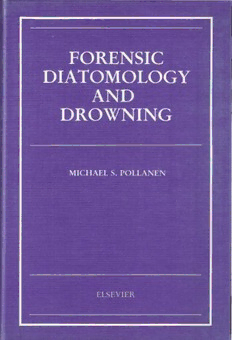Download Forensic Diatomology and Drowning PDF Free - Full Version
Download Forensic Diatomology and Drowning by M. S. Pollanen in PDF format completely FREE. No registration required, no payment needed. Get instant access to this valuable resource on PDFdrive.to!
About Forensic Diatomology and Drowning
The postmortem analysis of drowning is a classical problem in the pathology of sudden violent death. From a historical perspective, one of the most important issues in the study of drowning has been the search for a sensitive, specific, and easily applicable test for this cause of death. On this basis, the diatom test has emerged as the foremost laboratory procedure for the detection of drowning. Although the history of the diatom test spans a century, no comprehensive monograph has been published to address the scientific and medicolegal basis of the diatom test. This book is an attempt to fill this void in the English-language literature.The motivation and axiom for the diatom test are discussed in chapter 1 which outlines the types of circumstances bodies may be recovered from water. In chapter 2, drowning is considered in the broader context of rapid anoxial death and the postmortem findings of drowning is discussed. The medicolegal value and historical development of the diatom test are reviewed in chapter 3, which prepares the foundation for discussion of research on diatoms and drowning using femoral bone marrow (chapter 4). Chapter 4, the utility and validity of the diatom test is analyzed on a quantitative basis. Chapter 5 describes the laboratory procedures for extraction of diatoms from human tissues and presents guidelines for interpreting the diatom test in forensic casework. The various investigative applications of the diatom test are presented in chapter 6, with specific reference to the role of the diatom test in homicidal drowning. The final chapter, which forms a photomicrophic atlas of freshwater diatoms, will serve to guide forensic practitioners who are interested in performing forensic diatom analysis. The text is followed by a selected bibliography which includes references that may not have been cited in the main text.
Detailed Information
| Author: | M. S. Pollanen |
|---|---|
| Publication Year: | 1997 |
| ISBN: | 9780444828446 |
| Pages: | 165 |
| Language: | English |
| File Size: | 90.283 |
| Format: | |
| Price: | FREE |
Safe & Secure Download - No registration required
Why Choose PDFdrive for Your Free Forensic Diatomology and Drowning Download?
- 100% Free: No hidden fees or subscriptions required for one book every day.
- No Registration: Immediate access is available without creating accounts for one book every day.
- Safe and Secure: Clean downloads without malware or viruses
- Multiple Formats: PDF, MOBI, Mpub,... optimized for all devices
- Educational Resource: Supporting knowledge sharing and learning
Frequently Asked Questions
Is it really free to download Forensic Diatomology and Drowning PDF?
Yes, on https://PDFdrive.to you can download Forensic Diatomology and Drowning by M. S. Pollanen completely free. We don't require any payment, subscription, or registration to access this PDF file. For 3 books every day.
How can I read Forensic Diatomology and Drowning on my mobile device?
After downloading Forensic Diatomology and Drowning PDF, you can open it with any PDF reader app on your phone or tablet. We recommend using Adobe Acrobat Reader, Apple Books, or Google Play Books for the best reading experience.
Is this the full version of Forensic Diatomology and Drowning?
Yes, this is the complete PDF version of Forensic Diatomology and Drowning by M. S. Pollanen. You will be able to read the entire content as in the printed version without missing any pages.
Is it legal to download Forensic Diatomology and Drowning PDF for free?
https://PDFdrive.to provides links to free educational resources available online. We do not store any files on our servers. Please be aware of copyright laws in your country before downloading.
The materials shared are intended for research, educational, and personal use in accordance with fair use principles.

